| Solar
Inventor Resources |
| New Inventions in Low-Cost Solar Heating
William Shurcliff
Click here for Extensive
Extracts from this book
|
 My all time favorite solar book.
Published in 1979, but still has many interesting concepts that are
well described. Out of print, but available at BookFinder, Amazon
used books, etc. My all time favorite solar book.
Published in 1979, but still has many interesting concepts that are
well described. Out of print, but available at BookFinder, Amazon
used books, etc.
The picture here is one of a hundred concepts in the book, each
interesting and well explained.
|
David Delaney's Site
David's site has gone offline, but still available on the Wayback
Machine: https://web.archive.org/web/20181103113700/http://davidmdelaney.com/
Original Website: http://davidmdelaney.com/
|
 This is David Delaney's site. He usually
has some new and interesting ideas cooking. This is David Delaney's site. He usually
has some new and interesting ideas cooking. |
| Phase Change Materials Homepage
http://freespace.virgin.net/m.eckert/index.htm
One PCM supplier
http://www.rubitherm.com/english/index.htm
|
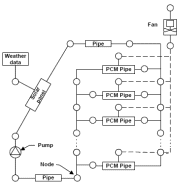 The latest on the
application of phase change materials for heat storage. The latest on the
application of phase change materials for heat storage. |
| Potential
DIY Phase Change Material for Heat Storage
|
Nick Pine posted this note
describing a phase change material for heat storage that was
developed by George Lane some years ago. It appears to have some
potential for use as a low cost, home made heat storage material in
solar heating systems. |
| Electric Bicycle Experiments
http://electric-bicycle-experiments.com/
|
 A large
collection of experimental electric bikes and trikes. Some with
fairly detailed descriptions. A large
collection of experimental electric bikes and trikes. Some with
fairly detailed descriptions. |
| Backyard
Inventor Projects -- modest to moderate
size projects that any of us could think about working on |
| Looking
for a good overwindow collector design... |
 This is a first cut at
finding a nice looking over window solar collector design that
produces a worthwhile amount of home heating. This is a first cut at
finding a nice looking over window solar collector design that
produces a worthwhile amount of home heating.
It has a ways to go, but maybe you have some suggestions to make
it better? Lets hear from you.
|
|
An Easy
to Build Earth-Sun Simulator for Optimizing Reflectors and
Shawdowo Studies...
Also, see the new
section on reflectors, including reflector performance ans
sizing tables, reflector desgin notes, and several examples of
using reflectors ...
|
 This is an earth-sun
simulator you can build to test reflector designs or to understand
sun and shade patterns on anything you can build a model of. This is an earth-sun
simulator you can build to test reflector designs or to understand
sun and shade patterns on anything you can build a model of.
It allows you to see the sun and shadows for any location on the
earth and any season and for any time of day. By rotating the
turntable you can quickly play the sun over your model for a full
day and see the sun and shade patterns. You can take readings on
the model with a light meter and get a quantitative idea how much
(for example) a reflector is increasing radiation.
|
|
Waterbag
Solar Water Heating Collector Using Inflatable Film Cover and
Soap Bubble Insulation....
|
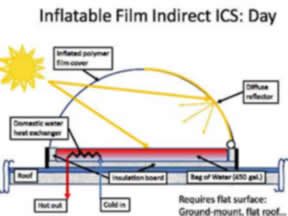 A
unique new design proposal from Nick Pine for an inexpensive solar
water heater that may be capable of very high solar fractions and
short payback. A
unique new design proposal from Nick Pine for an inexpensive solar
water heater that may be capable of very high solar fractions and
short payback.
It uses an inflatable cylinder made from poly film over a water
bag heat storage. Soap bubbles are used for night insulation.
|
|
Off The Shelf Solar DHW -- Cheap and Easy DIY Solar Water Heating
All the details on
the prototype...
Update March
2013: A glazed version of this system...
|
 The
goals of this system is to provide an easy to build and inexpensive
solar water heating system that uses all off the shelf components
(i.e. nothing to build yourself -- just assemble). The
goals of this system is to provide an easy to build and inexpensive
solar water heating system that uses all off the shelf components
(i.e. nothing to build yourself -- just assemble).
This is a four season drain back system. While the parts are
inexpensive, they are high quality and the life and reliability
should be comparable to commercial systems.
Total cost is projected to be about $1300, and the system qualifies
for federal and some state rebates.
The system is in the design and prototyping stage -- comments and
suggestions are most welcome.
All the details on the
prototype... |
Building
and Using a Blower Door -- A DIY Blower Door you can Build for $30
All the
details on our homemade blower door... |
 This is our homemade blower door that uses a furnace
blower for the fan. This is our homemade blower door that uses a furnace
blower for the fan.
The writeup gives all the details on building and using the blower
door, and the methods
you can use to compare your house tightness to others as well as
estimate the heat loss and carbon emissions associated with
infiltration. and the methods
you can use to compare your house tightness to others as well as
estimate the heat loss and carbon emissions associated with
infiltration.
With a little scrounging, the blower door and instrumentation can be
built for $30. |
|
DIY Blower Door
Plans -- North Dakota Sate University Extension
Plans
for blower door....
URL
for NDSU Extension service -- many free plans...
|
 This is a set of plans
from the North Dakota State University extension for a DIY blower
door. This is a set of plans
from the North Dakota State University extension for a DIY blower
door.
I ran into these plans after building the blower door just above
-- not sure which is easier or cheaper or better.
|
| A $6/sqft solar
collector using Copper tubing and Aluminum fins
Full Details ...
Gary
This collector is an offshoot of the collector just below. It
uses the same scheme to transfer heat from the aluminum fin to the
heat transfer tubing, but copper is used instead of PEX for the
tubing. This adds a modest amount to the cost per sqft, but
provides performance that is quite close to all copper commercial
collectors.
|

 This is a cut at a solar water heating
collector that offers a combination of high performance with a low
cost per sqft, and an easy build. This is a cut at a solar water heating
collector that offers a combination of high performance with a low
cost per sqft, and an easy build.
See what you think!
The fin to tube thermal connection is similar to the collector
above, but copper is used for the tubing instead of PEX. This
provides performance
within 4% of an all copper collector in an easy to build package.
Extensive build,
testing, and performance information is provided...
|
| A $4/sqft solar
collector using PEX tubing and Aluminum Fins
Full Details...
Gary
There has been a lot of interest in a collector that uses PEX
tubing rather than copper to convey the heat transfer fluid. Here
is a cut a collector that does this -- with careful attention to
the PEX/fin joint, it can perform surprisingly well.
|
 This is a cut at a solar
water heating collector that uses PEX tubing instead of copper to
convey the heat transfer fluid. The fins are aluminum, and a lot
of effort was put into attaining a good thermal bond between the PEX
and aluminum. Testing indicates
that the collector performs at 84% of and all copper commercial
collector at about 1/7th the price. This is a cut at a solar
water heating collector that uses PEX tubing instead of copper to
convey the heat transfer fluid. The fins are aluminum, and a lot
of effort was put into attaining a good thermal bond between the PEX
and aluminum. Testing indicates
that the collector performs at 84% of and all copper commercial
collector at about 1/7th the price.
Extensive build,
testing, and performance information is provided...
|
| A $1000 solar
water heating
Full Details ...
Gary
This is a cut at a system that performs well, lasts a long time,
and is easy to build.
As of 9/29/2008, the system has been in operation for about 3
weeks, and is working well, and has supplied 100% of our water
heating needs.
|
 This is a cut at $1000, cold
climate, high performance, long life, low maintenance, and easy to
build solar water heating system. This is a cut at $1000, cold
climate, high performance, long life, low maintenance, and easy to
build solar water heating system.
It combines one of the two collector designs just above with a
very simple drain back scheme. A unique heat exchanger that is
inexpensive and very efficient is used.
Extensive build, testing, and
performance information is provided ...
|
|
Serpentine
Drainback Solar Space Heating Project and Design Manual...
|
 This is a very unique
solar space heating collector. The absorber covers the entire
south wall right to the peak -- this is made possible by using an
absorber that is plumbed with tubes in a serpentine pattern rather
than they usual vertical riser pattern. The serpentine pattern
allows the absorber to be fit to the entire wall area and to
extend all the way up to the peak. The full wall glazing makes for
a very nice looking collector. This is a very unique
solar space heating collector. The absorber covers the entire
south wall right to the peak -- this is made possible by using an
absorber that is plumbed with tubes in a serpentine pattern rather
than they usual vertical riser pattern. The serpentine pattern
allows the absorber to be fit to the entire wall area and to
extend all the way up to the peak. The full wall glazing makes for
a very nice looking collector.
Several other unique features on the system, including a
partitioned tank for more efficiency.
The
builders provide a very complete 36 page manual that details the
design and build in great detail...
|
| How to make collector fins
and evaluate collector fin designs
How to make
and evaluate collector fin designs...
|
 This article
covers the various ways people have worked out for making the heat
absorbing fins for collectors, fin performance, and some
construction tips. This article
covers the various ways people have worked out for making the heat
absorbing fins for collectors, fin performance, and some
construction tips.
How to make
and evaluate collector fin designs...
|
The Sungrabber Unglazed Solar Water
Heating System
Description and some thoughts... |
 This
is an innovative solar water heating system that uses unglazed
collectors with drain back for freeze protection. This
is an innovative solar water heating system that uses unglazed
collectors with drain back for freeze protection.
It appears to offer some advantage for milder winter climates.
Description and some thoughts... |
Build a Solar
Attic,
Rob, www.IWillTry.org
www.iwilltry.org/b/projects/solar-attic/
|
 This is a very nice project to
incorporate a solar heating collector into a home's basic roof
structure. This is a very nice project to
incorporate a solar heating collector into a home's basic roof
structure.
Rob describes in detail the first stag e of incorporating the
collector glazing into his new roof. e of incorporating the
collector glazing into his new roof.
He will now experiment with various sort of collector designs behind
the glazing. Add a comment into his blog to encourage him to keep
us up to date on how he is doing!
(thanks to Erik for suggesting this link) |
Thermosyphon
Solar Water Heating System Tests,
Gary
Test of the PEX/Aluminum
collector...
Test of the
Copper/Aluminum collector...
|
 Some tests to determine how well two of
our homemade collectors perform in a simple thermosyphon solar water
heating system -- and, just to learn a bit about thermosyphon
systems. Some tests to determine how well two of
our homemade collectors perform in a simple thermosyphon solar water
heating system -- and, just to learn a bit about thermosyphon
systems.
There are some questions here for a passing thermosyphon expert to
answer for extra credit.
Test of the PEX/Aluminum
collector...
Test of the
Copper/Aluminum collector...
|
Converting
a Clothes Dryer to Use Solar Heated Attic Air
All the details on Randy's
solar dryer conversion... |
 Randy has worked out a way to convert a
conventional d dryer so that rather than using an internal heater to
make hot air do dry the clothes, he uses hot air produced by his
unique solar attic collector. Randy has worked out a way to convert a
conventional d dryer so that rather than using an internal heater to
make hot air do dry the clothes, he uses hot air produced by his
unique solar attic collector.
This cuts the cost and energy use and CO2 emissions to do a dryer
load by a factor of five! |
Solar
Cooking After Dark -- A Stored Heat Solar Cooker
Full
construction details... |
 This is a very interesting project from Mik that
gives the details on building a solar cooker that stores solar
energy in a bundle This is a very interesting project from Mik that
gives the details on building a solar cooker that stores solar
energy in a bundle of steel rods
during the daytime, and then uses the stored heat for cooking after
sunset. of steel rods
during the daytime, and then uses the stored heat for cooking after
sunset.
Mik is looking for ideas on improving the prototype.
Full
construction details...
|
| Solar Heated Livestock Watering Stock
Tank Prototype
Details ...
Gary
NOTE that this project has
progressed through a couple new versions -- see
this section for the latest "production" version...
|
 This is a first cut at a
livestock watering tank that is insulated and solar heated to keep
the water above freezing. This is a first cut at a
livestock watering tank that is insulated and solar heated to keep
the water above freezing.
The usual approach around here to keeping stock tanks from
freezing is to use an electric stock tank heater, which uses a lot
of electricity. This approach might eliminate or greatly reduce
the need to such heaters and the cost and GHG's that go with them.
Details ...
|
DIY Heat Recovery Ventilator (HRV)
Details on the DIY HRV ...HRV/ShurcliffHRV.htm
This is another brief description of a potential DIY HRV from the
RedRok site... |
 This is a short description of a DIY
HRV design that was developed at the University of Saskatchewan in
the 1980. This is a short description of a DIY
HRV design that was developed at the University of Saskatchewan in
the 1980.
The description is from a book on HRVs for homes written by William
Shurcliff in 1982 that gives a very readable description of how HRVs
work and quite a bit of design information.
If you know of any other DIY HRV designs, please le me know. |
| Optimal
Solar Air Collector Design
Details...
Gary
|
 Careful design
of air collector baffles and fins may allow high efficiency solar
air heating collectors that are still simple and cheap to build. Careful design
of air collector baffles and fins may allow high efficiency solar
air heating collectors that are still simple and cheap to build.
These collectors have the potential for 1 to 2 year paybacks on
material costs in cold climates.
|
| Horizontal
Pond Domestic Hot Water Heater
Gary and Nick
|
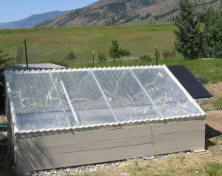 An experimental concept for a domestic
solar water heating that uses a pipe coil in a glazed pond to
collect energy. An experimental concept for a domestic
solar water heating that uses a pipe coil in a glazed pond to
collect energy.
The goal is to provide a full four season solar water heater with
the simplicity and low cost of a batch solar heater.
It is looking promising, but still some issues to resolve.
Comments welcome. |
| SunCache
Solar Water Heating -- Harpiris Energy
http://www.harpiris.com/
Video: https://www.youtube.com/watch?v=dnKD0A3p7xk
SRCC OG-300 certification results for CA zone 3:
http://www.solar-rating.org/...
This design was developed by the Davis
Energy Group in an effort to lower the price of solar water
heaters. The unique design allows more use of plastics resulting
in a lighter and less expensive design.
|
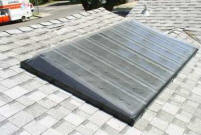 This is a soon to be commercially
available, low cost, Integral Collector/Storage solar water heater. This is a soon to be commercially
available, low cost, Integral Collector/Storage solar water heater.
The retail price for DIY installations is estimated to be $2200.
The collector has been SRCC certified, and will qualify for
incentive programs that require SRCC certification. There is a
CARB program that CA residents may want to check on.
The unit is designed for easy DIY installation -- for instance,
the plumbing connections to the collector are made with two
Sharkbite push in style fittings, and there are no controllers, or
heat exchangers to install.
The collector contains 50 gallons of water for thermal storage
that remains in the collector forever. Fresh water that is to be
preheated passes through a copper pipe heat exchanger immersed in
the collector water.
Note that the freeze tolerant temperature for this collector is
listed as 20F, so it is not intended for cold climates. The
testing indicates a savings for about 75 therms of NG per year for
a family of 4.
|
| Greenward Ridge
Vent Water Heating System
http://nuenergyalternatives.com/
Article with a bit of detail...
|
 A new idea for solar water heating. An
antifreeze fluid is circulated through the attic ridge vent to pick
up heat from the hot air exiting the ridge vent. The fluid is A new idea for solar water heating. An
antifreeze fluid is circulated through the attic ridge vent to pick
up heat from the hot air exiting the ridge vent. The fluid is routed
through a heat exchanger that is embedded in a solar preheat water
tank -- this preheats the water before it gets to the regular hot
water tank. routed
through a heat exchanger that is embedded in a solar preheat water
tank -- this preheats the water before it gets to the regular hot
water tank.
more (including a diy
alternative)...
(Thanks very much to Chris for finding this!)
|
| A unique solar
water heating design using flexible tubing compressed between
absorber plates
Full details:
http://www.solarfriend.co.uk/
|
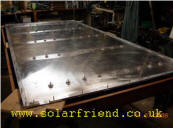
This new design uses silicone tubing that is compressed
(squashed) between two aluminum sheets. This is a unique approach
to providing a good thermal connection between the water carrying
tube and the aluminum absorber plate.

By squashing the tube, David gets a larger contact area and a good
tight fit of the aluminum to the tubing with no air gaps.
There is no test data comparing the thermal performance of this
arrangement to a metal tube with soldered or welded fin, but based
on the tests I've done with PEX tubing and aluminum fins, I think
the performance is likely to be somewhat less than the metal
tube/fin, but still quite good.
The way in which water systems are plumbed in the UK results in
low water pressure in the silicone tubing, and silicone has a high
temperature capability, so this may work out very well.
|
Double Play -- An
Experimental Solar Heating and Cooling System
Steve Baer
How to get articles from
Home Power ...
and the Zomeworks site
http://www.zomeworks.com
Roof
Integrated Solar Absorbers: The Measured
Performance of “Invisible” Solar Collectors
Preprint (700K pdf)
Roof Integrated Solar Absorbers -- slides
|
Roof Integrated Solar Absorbers
Home Power magazine article, issue 102
This innovative system uses unglazed collectors that are in tegrated with
the roof structure and a unique thermal storage system to provide
solar thermal heating in the winter and radiation cooling in the
summer. Amazing! tegrated with
the roof structure and a unique thermal storage system to provide
solar thermal heating in the winter and radiation cooling in the
summer. Amazing!
The pdf report provides detailed performance measurements from
the FSEC & NREL.
|
Theoretical
Evaluation of the NightCool Nocturnal Radiation Cooling Concept
Danny S. Parker
Florida Solar Energy Center (FSEC)
New report on the NightCool performance in test buildings:
Experimental
Evaluation of the NightCool Nocturnal Radiation Cooling Concept:
Performance Assessment in Scale Test Buildings,
Danny S. Parker, John R. Sherwin
Florida Solar Energy Center (FSEC)
Daily performance of the test buildings,
http://infomonitors.com/ntc/
Note: I would tend to NightCool in the Experimental area,
so, if you go after this, bear in mind you may suffer the "being
a pioneer" learning curve. Please let us know how it comes
out.
|
 This is a
simple, building integrated, cooling scheme that uses nighttime
radiation cooling from a metal roof to cool air in the attic space.
Attic air is then circulated into the living area to provide
cooling. This is a
simple, building integrated, cooling scheme that uses nighttime
radiation cooling from a metal roof to cool air in the attic space.
Attic air is then circulated into the living area to provide
cooling.
A simulation model is used to predict performance in various
climates -- the scheme works very well in dry areas, and fairly well
even in very difficult moist-warm climates (e.g. Florida).
One of the attractive features of this system is that the roof is
very conventional -- no massive ponds or moving insulation.
There is the potential in some climates to use the same metal
roofing/attic system for space heating in colder weather.
The new test report shows the results for two 10' by 16' structures
that were built to compare NightCool performance to conventional AC
in Florida. Very interesting and promising results.
Tests of a a simple dehumidification system using desiccants are
now underway. |
| The Rotating Solar Boiler
The Whole Story...
|
 A new idea for low cost, high temperature solar
collectors. A new idea for low cost, high temperature solar
collectors. |
| Simple
Pool Heating Idea
Gary
|
 This is an idea
for a simple, cheap and efficient homemade pool heating collector. This is an idea
for a simple, cheap and efficient homemade pool heating collector.
|
| Solar Shed for Space Heating
House
Solar
Shed
Gary
|
 This idea uses
solar collectors and heat storage tank installed in a multi-purpose
outbuilding to provide space heating for the nearby house. This idea uses
solar collectors and heat storage tank installed in a multi-purpose
outbuilding to provide space heating for the nearby house. |
|
Night Air Thermal Mass Cooling
Using Water Barrels
All the
details on water barrel space cooling...
|

This is a scheme that I am experimenting with to cool my shop. It
basically blows cool night time air over a collection of 50 gallon
barrels filled with water to store "coolth" in the water.
The method looks like it might provide cooling with a COP of 42
(SEER 140) or more!
While I am using the scheme in my shop, it could be used to cool
any interior space. The
basic question is: does
it make sense to use a fan forced flow of cool night air over
thermal mass to store "coolth" for later use in daytime cooling?
Details...
|
| Evapro-radiative Cooling
Thoughts
Full Story ...
|
 This is exactly
the same collector listed just above, but used for cooling instead
of heating. The idea is that at night water from a storage tank is
pumped over the collector surface to cool. The water cools by
radiation to the night sky and evaporation. The chilled water in
the storage tank would be used for space cooling the next day. This is exactly
the same collector listed just above, but used for cooling instead
of heating. The idea is that at night water from a storage tank is
pumped over the collector surface to cool. The water cools by
radiation to the night sky and evaporation. The chilled water in
the storage tank would be used for space cooling the next day.
And, some thoughts on practical cooling and heating applications
using this scheme. Full
Story ... |
| Full
Scale Version of Evapro-radiative Cooling System
|
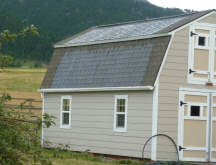 This is a first cut at a full scale
implementation of the evapro/radiative cooling system described just
above. This is a first cut at a full scale
implementation of the evapro/radiative cooling system described just
above.
It uses our existing solar space heating system as a base, and
manages to add the cooling function with very little additional
work or cost.
|
|
Using
Your Lawn Sprinkling Water to Cool the House
|
 Rick
uses a water to air heat exchanger to extract some "coolth" from the
water he is using to water the lawn. Rick
uses a water to air heat exchanger to extract some "coolth" from the
water he is using to water the lawn.
Its basically free cooling.
All the
details on Rick's cooling setup... |
| Nathan's Low
Tech, High COP Air Conditioner
http://njhurst.com/blog/01265701097
|
 Nathan's low tech AC uses a tank with
cool water coupled to an air to an efficient air to water heat
exchanger (car radiator). Nathan's low tech AC uses a tank with
cool water coupled to an air to an efficient air to water heat
exchanger (car radiator).
It occurs to me that this could be coupled with the
Evapro-radiative cooling just above to make a very pretty cool
system.
|
| Experimental
Solar Collector Made from Twinwall Panel
www.instructables.com/ ...
|
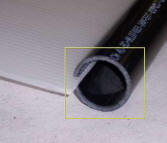 This is an interesting idea for a
collector. It uses the channels in a Twinwall glazing sheet as flow
passages for water. Slotted pipes fit over the ends of the twinwall
sheet to act as manifolds. This is an interesting idea for a
collector. It uses the channels in a Twinwall glazing sheet as flow
passages for water. Slotted pipes fit over the ends of the twinwall
sheet to act as manifolds.
I'm a bit skeptical of the temperature capability, leak sealing, and
life of this panel, but its certainly an interesting idea.
Finding a twinwall that holds up to long term exposure to hot water
may be a issue -- GE says that polycarb does not.
(thanks to Brent for finding this) |
| The Quest for an R15 Thermal Window Shade |
 Some thoughts on developing
high R value thermal window shades. Some thoughts on developing
high R value thermal window shades.
Such shades have the promise of greatly reducing window heat
loss, while still being convenient to use.
Details here ...
|
| An
Over and Around the Window Solar Air Heating Collector First Cut
Prototype
All the
construction and performance details...
|
 A first prototype of a solar air heating
collector that fits over an existing window, and uses the window to
get air into and out of the collector. A first prototype of a solar air heating
collector that fits over an existing window, and uses the window to
get air into and out of the collector.
This is a simple collector that could be installed seasonally.
The collector must, of course, be significantly larger than the
window itself.
First try
prototype and performance...
|
| Combined Solar Collector and
Window Shade
The Story
|
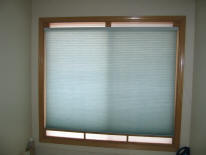 An insulating window shade
that also acts as a solar collector, and that automatically
transitions from one to the other depending on conditions. An insulating window shade
that also acts as a solar collector, and that automatically
transitions from one to the other depending on conditions. |
| Flow
Organizer |
 A try at the
Saunders/Delaney/Pine flow organizer. A try at the
Saunders/Delaney/Pine flow organizer. |
| The Integral Passive Solar
Water Heater Book, David Bainbridge
Download
this book
Even though the batch water heater design is an old one, I
think there is a great deal of opportunity for improvement. How
about an all season, $300 solar water heater with a payback of
one year -- this seems reachable to me with some refinement of
the designs.
This book is book is a great place to get up to speed on the
potential.
|
 This is a
really fine book on all aspects of designing and building a wide
variety of solar batch water heaters. This is a
really fine book on all aspects of designing and building a wide
variety of solar batch water heaters.
The book has a great mix of how-to and engineering design
information -- great for builders and experimenters.
Thanks to David, the full content of the book is available
here as a free download.
|
| Low
Tech Garage/Barn Heater (pdf)
Gary
|
 An experimental
idea for heating barn or workshop spaces. Inexpensive and
easy to build (honest!). An experimental
idea for heating barn or workshop spaces. Inexpensive and
easy to build (honest!).
|
| Solar Water Collector from CPVC Pipe
CPVC Collector Test
|
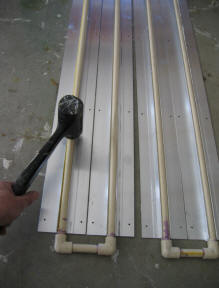 This is a try at a very easy
to build and cheap solar flat plate collector that uses CPVC pipe,
and extruded alum radiant floor heat spreaders. This is a try at a very easy
to build and cheap solar flat plate collector that uses CPVC pipe,
and extruded alum radiant floor heat spreaders.
Mixed results.
|
The Rutgers Solar Heating
System for Greenhouses
Mears, Roberts, Simpkins, and Kendall
Rutgers University
The Rutgers Solar Heating System for Greenhouse - 1977 (0.8
MB pdf)
Greenhouse
Solar Heating-1981 (2.5MB pdf)
|
 The solar collector shown here was developed in the
70's as a very inexpensive greenhouse heater. It works well for
situations in which only low temperatures are required (like
greenhouses and pools). The solar collector shown here was developed in the
70's as a very inexpensive greenhouse heater. It works well for
situations in which only low temperatures are required (like
greenhouses and pools).
While I do not know of anyone who has tried this as a pool
heater, it seems to me it might work well, and it would be very
inexpensive -- perhaps $2 per square foot?
The papers give information on a several greenhouse energy
schemes, so you have to wade through all this to find the details
on building the collector. The collectors described in the paper
a quite large, but could be scaled down. Note that even though
this is a very simple collector, there are details that you must
get right for it to hold together -- so read all the construction
notes.
If you build one of these PLEASE let me know -- Gary
A number of other interesting commercial greenhouse related
papers at the Rutgers Horticultural Engineering Website:
http://aesop.rutgers.edu/~horteng/
|
| Solar Closets and Sunspaces
Nick Pine and Paul Bashus
http://www.ece.vill.edu/~nick/solar/solar.html
|
 An interesting
idea for coupling a low thermal mass solar collection area with a
well insulated, high temperature heat storage area that is used as
a "solar battery" to heat the attached house during cloudy periods. An interesting
idea for coupling a low thermal mass solar collection area with a
well insulated, high temperature heat storage area that is used as
a "solar battery" to heat the attached house during cloudy periods. |
|
DIY
Grey Water Heat Exchanger for Showers...
|
 This is a simple and
effective grey water heat exchanger from Tyler that captures some
of the heat from your shower drain water in order to preheat water
on its way to the shower. This is a simple and
effective grey water heat exchanger from Tyler that captures some
of the heat from your shower drain water in order to preheat water
on its way to the shower.
|
| Grey
Water Heat Exchanger In A Barrel
Nick Pine (with a little help from Gary)
Canada study and test of grey water heat recovery system for a
residence ( 3 MB pdf)
|
 An innovative
version of a grey water heat exchanger that may be able to recover a
large fraction of the heat that normally goes down the drain. It is
inexpensive and is constructed inside a standard steel barrel. An innovative
version of a grey water heat exchanger that may be able to recover a
large fraction of the heat that normally goes down the drain. It is
inexpensive and is constructed inside a standard steel barrel. |
| The Amazing Heat
Scavenger Experiment
www.voltscommissar.net/ ... .pdf
|
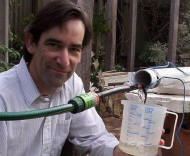 An interesting and simple
experimental setup to show the potential (and some of the problems)
of capturing heat from grey water from the shower. An interesting and simple
experimental setup to show the potential (and some of the problems)
of capturing heat from grey water from the shower. |
| Recovering Heat
From Shower Drain Water for Space Heating
www.builditsolar.com/Experimental/SewerPipeHeatRecovery/Sewer.htm
|
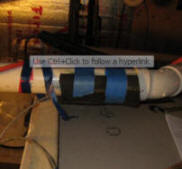 A potential simple scheme for recovering
heat in shower water for use in space heating is described. A potential simple scheme for recovering
heat in shower water for use in space heating is described.
Data from a small test to assess the feasibility of the scheme is
presented.
|
| An Approach
to Developing a Very Low Energy Use Shower
A odd ball, but very low
energy shower...
|
 An approach that
was looked into for implementing showers onboard commercial
airplanes is discussed as a potential very low energy approach for
home showers. An approach that
was looked into for implementing showers onboard commercial
airplanes is discussed as a potential very low energy approach for
home showers. |
| Recirculating Showers -- Yet another way
to save shower water and energy
Thoughts on a very
efficient shower design...
Ken's implementation of a
recirculating, high flow shower...
A Kohler add for a (sort of) recirculating shower...
|
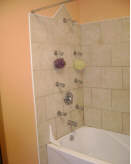 Thoughts and schemes to allow endless hot
water showers at high flow rates with very little energy use. Thoughts and schemes to allow endless hot
water showers at high flow rates with very little energy use.
|
Integral
Stagnation Temperature Control For Solar Collectors (pdf)
S.J. Harrison, Q. Lin, and L.C.S Mesquita
Department of Mechanical and Materials Engineering, Queen's
University, Kingston, ON, Canada
SESCI 2004 Conference
|

A passive approach to automatically decreasing the stagnation
temperature of solar collectors. An air channel behind the
absorber plate is used to ventilate the collector when the
temperature exceeds a set value. A valve at the top of the air
channel opens automatically at a set temperature.
|
|
http://www.tdc.ca/bubblegreenhouse.htm
|
 A scheme to use soap bubbles as
insulation on greenhouses (or other structures) to prevent night
heat loss. A scheme to use soap bubbles as
insulation on greenhouses (or other structures) to prevent night
heat loss. |
| Solar Bubble Build
www.solarbubblebuild.com/build_images13.php
|
 Pretty detailed description
of a building using the soap bubble insulation scheme. An
interesting site -- with some new ideas. Pretty detailed description
of a building using the soap bubble insulation scheme. An
interesting site -- with some new ideas.

|
How to Build
a Heliostat for Solar Heating and Lighting,
Rob, www.IWillTry.org
http://www.iwilltry.org/ ...
|
 
Rob's heliostat -- reflects solar light and heat into a window
in your house.
An interesting idea if your house is lacking in south windows.
Some detail provided on the construction.
|
| Inflatable Heliostat
Download
full report pdf (3.5 mb)
Mithra and Gary
Surya
-- a cylindrical tracking inflatable concentrating PV solar
collector...
Patent for the
Surya... (pdf)
|
 An
experimental, low-cost heliostat design that uses air pressure to
focus and support the mirror. An
experimental, low-cost heliostat design that uses air pressure to
focus and support the mirror.
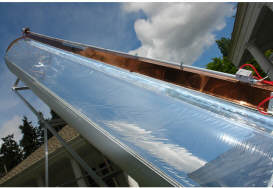
NEW This
is the follow on version of the inflatable heliostat design that
uses a tracking inflatable reflector to concentrate energy on a
line of PV cells --->
|
|
RIC Enterprises ...
|
 This is the site of my friend, co-worker,
and very creative inventor -- Mithra. We have worked together on
several projects, including the inflatable heliostat just above. This is the site of my friend, co-worker,
and very creative inventor -- Mithra. We have worked together on
several projects, including the inflatable heliostat just above.
The
Inventions page on Mithra's site has some very interesting
ideas. |
| Paper on PV powered
irrigation system has a unique(?) combination of fixed reflectors
and 1 axis tracking to increase PV panel output
Helikson, Haman, and Baird
The
Paper (pdf)
|
 This paper on a PV powered irrigation pumping
includes an interesting scheme to increase PV output. It has fixed
reflectors on each side of the PV panels, and a single axis tracking
system to point the entire rig toward the sun. The reflectors are
said to increase panel output by 33% (not counting the tracking
benefit). This paper on a PV powered irrigation pumping
includes an interesting scheme to increase PV output. It has fixed
reflectors on each side of the PV panels, and a single axis tracking
system to point the entire rig toward the sun. The reflectors are
said to increase panel output by 33% (not counting the tracking
benefit).
Does this seem like a good idea?
|
| Solar
Heated Home Using An Attached Greenhouse and Woodburning Stove
David Mears
The Paper (pdf)
A short article in Live Science on David's house
|
 This 1981 paper with a 2004 update describes a solar
heated house with a "flooded subfloor" thermal storage area. This 1981 paper with a 2004 update describes a solar
heated house with a "flooded subfloor" thermal storage area.
Seems like an interesting concept. Test data for a real house is
provided.
|
| Papercrete Construction
www.papercrete.com/papercrete.html
oikos.com/library/papercrete/sandshouse.html
www.northcoast.com/~tms/papercrete.html
|
 
PaperCrete is a building material made from a mixture of recycled
paper, sandy dirt, and a little cement. It has an R value of 2.8
per inch, good strength, and is lightweight and inexpensive.  While
PaperCrete has been around quite a while, it has just started to be
used for home construction, so this is for adventurous
experimenters. While
PaperCrete has been around quite a while, it has just started to be
used for home construction, so this is for adventurous
experimenters.
 |
Roof Sprinkler Cooling System,
John
Full Details ...
|
 Roof sprinkler system lowers
roof temperature and cooling bills by keeping the roof cooler
through water evaporation. Roof sprinkler system lowers
roof temperature and cooling bills by keeping the roof cooler
through water evaporation.
Added a description of another similar system 3/6/07 |
|
An
Experimental Trickle Down Solar Water Heating System
|

Lu has designed, built and tested a version of the Thomason
trickle down collector with some unique features.
The system includes a unique trickle down collector, a storage
tank with a new liner design, and an innovative version of a
copper heat exchanger.
|
| The mb-soft
compost heating schemes
Details here...
|
 This is an interesting set of concepts
that use the heat generated through the decomposition of organic
mater for space and water heating. This is an interesting set of concepts
that use the heat generated through the decomposition of organic
mater for space and water heating.
Details...
|
| Interesting
New Projects |
| Drake Landing -- Community
with Solar Seasonal Storage for Water and Space Heating
http://www.dlsc.ca/index.htm
Brochure:
http://www.dlsc.ca/DLSC_Brochure_e.pdf
Photos:
http://www.dlsc.ca
Modeling of Borehole Storage:
www.trnsys.com (pdf)
YouTube
Video on Drake Landing ...
|
 New Alberta
community uses 2300 sq meters of solar thermal collectors to collect
heat in the summer for use in the winter. Heat is stored in a field
of 144 boreholes, and distributed by a common heating loop serving
the 52 houses. New Alberta
community uses 2300 sq meters of solar thermal collectors to collect
heat in the summer for use in the winter. Heat is stored in a field
of 144 boreholes, and distributed by a common heating loop serving
the 52 houses. |
| Vertigro
Oil From Algae
www.valcent.net/s/Home.asp
On "The Energy Blog" ...
|
 This looks like a pretty simple way to
get sustain high growth rates and oil production from algae? This looks like a pretty simple way to
get sustain high growth rates and oil production from algae?
The video has the best description of the process.
|
| MIT's
Warm Light Wall System
http://content.zdnet.com/...
http://www.eebt.org/Trombe.html
|
 An interesting
solar wall/window construction that was used on the MIT Solar
Decathlon entry. An interesting
solar wall/window construction that was used on the MIT Solar
Decathlon entry.
The wall uses a layer of aerogel insulation (which transmits light)
and a glass block that is apparently filled with water to act as
thermal mass. It appears to have an insulation layer on the inside
as well (to control the heat transfer rate to the interior?).
It may provide some combination of solar gain, light, and storage in
one unit. As usual with solar decathlon projects, its hard to find
any details or performance -- if you find something, please let me
know. |
Road Energy System -- solar
heating from your parking lot
http://www.invisibleheating.co.uk/road-energy.htm
|
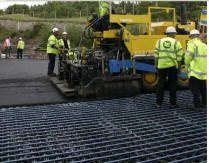 A system from
Invisible Heating Systems Ltd that embeds plastic pipe in asphalt
pavement to recover heat. A system from
Invisible Heating Systems Ltd that embeds plastic pipe in asphalt
pavement to recover heat.
No detail on what weather conditions lead to successful heat
recover, but maybe they will tell us how its working out in a
while. Seems like it might work well for public swimming pools with
large parking lots? |
| Elisolar
Thermal Shad Structures
http://www.eliosolar.com/
|
 Eliosolar makes a line of
architectural shading structures that double as solar water
heaters. So, potentially you get the double benefit of reducing the
building AC bills and also making free hot water. They are in the
process or getting SRCC approval, and it will be interesting to see
what the efficiency as solar water heaters comes out to, but even if
its quite low (as one would expect from the unglazed design), maybe
the double benefit makes it worthwhile. Eliosolar makes a line of
architectural shading structures that double as solar water
heaters. So, potentially you get the double benefit of reducing the
building AC bills and also making free hot water. They are in the
process or getting SRCC approval, and it will be interesting to see
what the efficiency as solar water heaters comes out to, but even if
its quite low (as one would expect from the unglazed design), maybe
the double benefit makes it worthwhile. |
Eco
Wave Power -- Simple Wave Power Generator
www.ecowavepower.com/ |
 Eco Wave Power is
developing a couple types of simple wave powered electric
generators. Eco Wave Power is
developing a couple types of simple wave powered electric
generators.
The designs are simple and might form the basis for a simple DIY
wave power generator, or at least provide some ideas. |
Cable
supported heliostat from Solaflect Energy
|
 For power
generation stations that use a central tower to collect sunlight
reflected from a field of heliotstat, the heliostats are the major
cost element, so simpler and cheaper heliostat designs have a big
payoff. For power
generation stations that use a central tower to collect sunlight
reflected from a field of heliotstat, the heliostats are the major
cost element, so simpler and cheaper heliostat designs have a big
payoff.
This new design by Solaflect Energy supports the heliostat mirrors
using mostly tension cables rather than the traditional heavy
bending structure.
Working on more efficient heliostat designs seems like a good
backyard inventor challenge. |
| Magenn Power Air Rotor System
An Helium inflated wind generator
As of Feb 2020, the Magenn site does not appear to exist anymore,
but Googling Magenn wind turbine brings up some descriptions
|
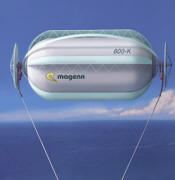 An
interesting idea for a helium inflated wind generator. An
interesting idea for a helium inflated wind generator. |
| Night Sky Roof Water Spray Cooling
system
www.pnl.gov/TechReview/whitecap/whitecap.html
EERE report (pdf)
http://www.davisenergy.com/NSFS10060.pdf
ORNL gov report
The first link above provides the most complete design information, and
describes three different roof spray system designs.
While these papers seem to be aimed primarily at commercial applications,
residential applications may well be workable, simple, and energy efficient.
Most beneficial for dry climates. |
 "This
innovation spray-cools water on the roof at night and applies the cooled
water to reduce subsequent cooling loads. On clear nights, the sky is much
colder than outdoor air, contributing to high water cooling rates through a
combination of evaporation and sky radiation. Overnight, NightSky systems
can typically cool a large storage volume (preferably two gallons per square "This
innovation spray-cools water on the roof at night and applies the cooled
water to reduce subsequent cooling loads. On clear nights, the sky is much
colder than outdoor air, contributing to high water cooling rates through a
combination of evaporation and sky radiation. Overnight, NightSky systems
can typically cool a large storage volume (preferably two gallons per square
foot of roof surface) to a final temperature as much as 12 degrees below the
minimum night air temperature."Seems like a very promising way to reduce
the energy cost of cooling. The 5600 sqft prototype described in the
first link achieved an EER of 149.
It seems like this system while currently used for
commercial buildings is simple, and might well be adapted to cooling a
residence?? The first link gives some useful design guidance on
cooling per sqft, tank sizes, ... |
|
Solar Thermal Electric Power Plant
http://pesn.com/2006/02/12/9600234_Schott_solar_thermal_plant/
|
 A
new solar thermal electric power generation installation in Nevada with some
improvements. A
new solar thermal electric power generation installation in Nevada with some
improvements. |
|
MICHAEL JANTZEN Designer
http://www.walrus.com/~ddprod/michaeljantzen/index.html
|
 Michael
has shows some interesting concepts in home/building design. Some of
these have the potential for good energy efficiency -- as in the Home-Scape
pictured here. Michael
has shows some interesting concepts in home/building design. Some of
these have the potential for good energy efficiency -- as in the Home-Scape
pictured here. |
|
Mobile Window Thermal Test (MoWiTT) Facility
http://windows.lbl.gov/facilities/Mowitt/Default.htm
|
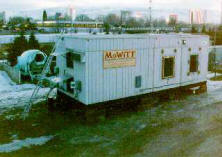 An
interesting test rig to measure the side by side performance of two test
windows under actual field conditions. An
interesting test rig to measure the side by side performance of two test
windows under actual field conditions. |
|
Interesting New Products |
|
Solarcentury solar thermal and solar electric
roof tiles
http://www.solarcentury.co.uk/installers-and-roofers/products/
The data sheet, brochure, and video show pretty good installation detail. |
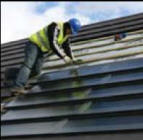 An
interesting new UK product. These are standard roof tiles that are
solar collectors. There is a solar thermal version that heats water,
and a solar An
interesting new UK product. These are standard roof tiles that are
solar collectors. There is a solar thermal version that heats water,
and a solar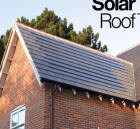 PV version that generates electricity.
PV version that generates electricity.
The thermal versions appear to come in pre-plumbed horizontal runs of
several tiles.
(thanks to Doug for finding this)
May 2011: It looks like the solar thermal version is no longer offered? |
Advanced Thermal Solar System With Heat Storage
For Residential House Space Heating (pdf)
Kazimierz SzymochaSESCI 2005 Conference
http://www.arc.ab.ca
|
 An
interesting concept for a solar wall heater. The absorber has
integrated heat storage in the form of Phase Change Material. The
objective is to store heat during the day in the PCM, and let the PCM warm
the wall that the collector is mounted on at night -- this reduces heat loss
through the wall. More... An
interesting concept for a solar wall heater. The absorber has
integrated heat storage in the form of Phase Change Material. The
objective is to store heat during the day in the PCM, and let the PCM warm
the wall that the collector is mounted on at night -- this reduces heat loss
through the wall. More... |
|
Vacuum Insulation Panels
www.vacuuminsulation.co.uk/index.html
More on vacuum panels:
http://huskinsulation.com/insulation/
www.boston.com/business/ticker/2009/05/husk_insulation.html |
 These
panels have R values that are about 10 times greater per inch that
conventional insulating materials. These
panels have R values that are about 10 times greater per inch that
conventional insulating materials.They are made by placing a gas tight
film over a porous but rigid material. The air is then evacuated from
the porous core to make the high R value panel.
There are some obvious questions regarding accidental punctures and leakage
rates, but, none the less, a potentially very useful material. |
|
Aerogel Insulation
http://aerogel.jpl.nasa.gov/about_aerogel.htm
http://en.wikipedia.org/wiki/Aerogel
|
Aerogel is a rigid, low thermal conductivity material that holds great
promise for very high R values in very little space if the price can be
brought down.
NASA:
"Currently the popular insulation material is fiberglass. Three-inch
thick fiberglass insulation has an R value of 13 while six-inch has an R
value of 19. However, only a half-inch thick piece of silica aerogel
will have an R value of 40. Both are are made of silica, but with
radically different structures, yet this structural difference makes a
drastic difference in thermal insulation performance."
|
|
Hot Harry Gough Industries
www.greenhouse.gov.au/renewable/recp/solar/two.html
download Hot Harry pdf |
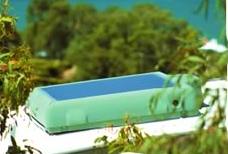 This
Australian design has some features in common with the Horizontal Pond
scheme just above, and some new features. The case is rotationally
molded PE, it incorporates two layers of glazing with a transparent
honeycomb material between them for insulation. The sun heats the
bath, and transfers heat to an immersed coil of copper pipe. The
prices seem on the high side given what looks like a cheap manufacturing
process? This
Australian design has some features in common with the Horizontal Pond
scheme just above, and some new features. The case is rotationally
molded PE, it incorporates two layers of glazing with a transparent
honeycomb material between them for insulation. The sun heats the
bath, and transfers heat to an immersed coil of copper pipe. The
prices seem on the high side given what looks like a cheap manufacturing
process? |
|
Combined PV - Air Collector as Heat Pump Air Pre-heater H. A. Zondag
Download details pdf |
 An interesting idea to use the normally wasted heat from PV panels for
thermal heating. Should about triple the useful energy output
from the PV panel. An interesting idea to use the normally wasted heat from PV panels for
thermal heating. Should about triple the useful energy output
from the PV panel. |
|
PVT Solar, Inc -- Echo Combined PV and Thermal System
PVT Solar
Website...
Demo Video
-- this is probably the best overview of how the system works...
Some pdf downloads that provide a little (very little) detail...
An Inhabitat article that has some pictures of the system...
There is an SRCC report on a "Cleanline PV" that may be this system...
|
 This
system is a combined PV and solar thermal system. Conventional PV
panels are mounted above the roof plane leaving a space between the roof and
the bottom of the PV panels. The top and sides of the PV array are
sealed to the roof. Fresh air is drawn in under the PV panels along
the open bottom edge, and is heated as it progresses up between the hot PV
panels and the roof. Vents at the top of the array take the heated air
into the house and use the heated air to heat domestic water and/or for
space heating. This
system is a combined PV and solar thermal system. Conventional PV
panels are mounted above the roof plane leaving a space between the roof and
the bottom of the PV panels. The top and sides of the PV array are
sealed to the roof. Fresh air is drawn in under the PV panels along
the open bottom edge, and is heated as it progresses up between the hot PV
panels and the roof. Vents at the top of the array take the heated air
into the house and use the heated air to heat domestic water and/or for
space heating.
The PVT website does its best to not provide much of any useful detail on
how the system is built -- the links to the left are the best I could find
-- let me know if you find a more detailed description.
From a thermal point of view, the system is basically an unglazed
collector that takes in ambient air and heats it all the way up to
temperatures good for space heating (most solar heating systems get a head
start by heating room temp air up). I would think that this might work
well in some climates, but the combination of unglazed collectors and
heating all the way from ambient would seem to limit its use in cold
climates? The SRCC report (link at left) would seem to confirm this if
it is for the same system -- the efficiency curve intercept is 0.24.
This is a very simple concept, and could certainly be implemented on a
DIY basis. While the thermal performance is likely to be well
under a good dedicated thermal collectors, the extra "free" thermal energy
would likely be more than the electrical energy the PV array generates.
Would love to hear from anyone who has one of these systems, or know more
about them. |
|
SolarWall PV/T
Overview SolarWall PV/T...
A Discovery Channel video on the system...
|
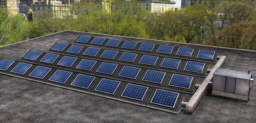
This is a variation on
SolarWall's well know transpired solar air heating collector system.
In this version, PV panels are spaced over the transpired collector
absorbers. The SolarWall collectors draw in the heated air behind the
PV panels.
It would be interesting to know how the thermal efficiency of this PV
version of the solar wall compares to a regular solar wall. I would
think the addition of the PV panels may reduce the thermal efficiency of the
SolarWall because PV panels would not be as efficient an absorber as the
SolarWall absorber they are shading?
I did not see any detailed performance numbers.
(thanks to Paul for suggesting this) |
Sunflower 250 -- Concentrating PV,
Energy Innovations
www.energyinnovations.com/sunflower250.html
|
 An
interesting concentrating PV design. First deliveries for early 2007. An
interesting concentrating PV design. First deliveries for early 2007.
"Now standing at a little over five feet square and five feet high, the 25X
Sunflower™ is able to meet our targets for both energy generation and cost.
Each of the 25 1'x1' mirrors is separately aligned, and yet all are attached
to and moved together by an undercarriage controlled by just two motors. The
receiver is approximately the size of one mirror and contains a collection
of small cells that are wired together to produce electricity. It is backed
by fins that dissipate heat and keep the cells operating within 30°C of
ambient temperature at all times." |
|
Greenway -- a PV system designed for DIY
installation
www.greenraysolar.com
A little more detail on the system:
www1.eere.energy.gov/solar/... |
 Greenway is developing a PV
module with an integrated inverter. Detail is a bit sketchy, but it
appears that the intent is that these modules can be strung together, and
then plugged into an outlet. They are specifically designed for easy
DIY installation. Greenway is developing a PV
module with an integrated inverter. Detail is a bit sketchy, but it
appears that the intent is that these modules can be strung together, and
then plugged into an outlet. They are specifically designed for easy
DIY installation.
This seems somewhat similar to the
Enphase system,
but with even more straight forward installation.
Its hard to tell how far along they are, but the do have some gov and
private funding. |
|
Home
CoGeneration Units Honda Version:
Honda Micro CHP
Home Cogeneration System
Article on home CoGeneration:
http://www.looksmarthouston.com
The Marathon Version:
www.marathonengine.com/Cogeneration.html
Infinia:
www.infiniacorp.com/ ...
An assessment of CHP from ToolBase.org:
http://www.toolbase.org
Some early testing in US:
www.csmonitor.com/2006/1114/p01s02-usec.html
Capstone Micro Turbine -- turbines for CHP, hybrid vehicles, power
generation, ...
http://www.capstoneturbine.com/ |
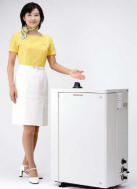 Home
cogeneration systems offer the possibility of putting the waste heat
produced when generating electricity to a useful purpose (heating your
home). The end result could be some cost saving, and an about 30%
reduction in green house gas production. Home
cogeneration systems offer the possibility of putting the waste heat
produced when generating electricity to a useful purpose (heating your
home). The end result could be some cost saving, and an about 30%
reduction in green house gas production.
As seems to be usual with any new technology to reduce energy use and
pollution; availability and adoption in the US is slow. |
|
Whisper Gen -- CoGeneration
http://www.whispergen.com/index.cfm
|
 Another
residential cogeneration system that comes in either an on-grid AC version
or and off-grid DC version. Another
residential cogeneration system that comes in either an on-grid AC version
or and off-grid DC version.
The website provides quite a bit of detail.
Not currently available in the US? |
Some Test Results
This just a place to put the results from some random tests
that were run to settle some burning issue. |
|
DIY Solar Air Heating Collectors: Pop Can vs Screen Absorbers...
|
 A side by side test of two of the most popular solar air heating collector designs: the pop can absorber and screen absorber. A side by side test of two of the most popular solar air heating collector designs: the pop can absorber and screen absorber.
Detail on:
- Collector basics and measuring performance
- Building each collector
- Side by side testing and performance
- Flow distribution and thermal images
- Cost of materials
|
|
Testing the Transmittance of Some Common Solar Collector Glazing Materials
|
 This is a test of the transmittance of a few glazing materials that are commonly used in DIY solar collectors. This is a test of the transmittance of a few glazing materials that are commonly used in DIY solar collectors.
It also looks at loss in transmittance with age.
|
TMeasuring Heat Transfer Coefficient for Solar Heating (Cooling) Systems Using Water Container |
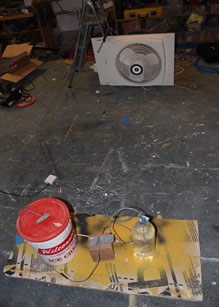 This test is a cut at measuring the heat transfer coefficient between the air surrounding a container of water and the container. The test is done for still air and for air velocity of 260 fpm. This test is a cut at measuring the heat transfer coefficient between the air surrounding a container of water and the container. The test is done for still air and for air velocity of 260 fpm.
This heat transfer coefficient is important for estimating the amount of heat that can be added to or removed from water heat storage containers by flowing hot or cold air over them.
|
Stagnation test on vertical double glazed collector...
|
 This
is a stagnaton test on our $2K vertical double glazed collector. This
is a stagnaton test on our $2K vertical double glazed collector. |
|
Comparing the Performance of Two DIY Solar Water
Heating Collectors -- CPVC vs Copper
All the details on CPVC collector performance test...
|
 I
did a side by side test of Scott's new design I
did a side by side test of Scott's new design
 of
the CPVC/aluminum collector comparing it to the copper/aluminum
collector. of
the CPVC/aluminum collector comparing it to the copper/aluminum
collector.
The performance of the CPVC collector was good, and I think that this CPVC
design offers another option for DIY solar collectors.
The CPVC collector is easy to build and would make a good first solar
project.
All
the details on CPVC collector performance test... |
|
CPVC, PEX and PEX-AL-PEX in
a short elevated temperature test
|
 This
was a quick test to see how CPVC and PEX faired in elevated temperatures up
to about 260F. This
was a quick test to see how CPVC and PEX faired in elevated temperatures up
to about 260F. |
A Sun Simulator for Collector Testing
The details... |
 This
is a project to do a sun simulator that will allow indoor testing of
collectors up to 2 by 4 ft. This
is a project to do a sun simulator that will allow indoor testing of
collectors up to 2 by 4 ft.
This is an active project and I could use some help on the reflector
design -- have a look and see if you have some
ideas... |
|
Deep Mesh Solar Air Heating Collector -- Test 1
Deep Mesh collector test 1...
|
 This
is a first test of a collector design that Nick Pine has proposed that
promises to provide higher collector output temperatures without as much
degradation in efficiency as usually occurs. This
is a first test of a collector design that Nick Pine has proposed that
promises to provide higher collector output temperatures without as much
degradation in efficiency as usually occurs.
The higher collector output temperatures are helpful in systems with heat
storage as more heat can be stored in a smaller space with higher
temperatures. |
Testing on our
shop heating thermosyphon collector -- including efficiency, flow rate, and
effect of smaller vents...
|
 Some
new testing on our nearly 10 year old thermosyphon solar shop heating
collector. Some
new testing on our nearly 10 year old thermosyphon solar shop heating
collector.
Testing
includes the performance effect of reducing vent size, and measurements of
efficiency and flow rate.... |
|
Air flow distribution for a
horizontal solar air heating collector with screen absorber
Details...
|
 An
attempt to get an idea whether the flow distribution in horizontal
collectors with horizontal airflow tends to be distorted by the buoyancy
forces on the heated air. An
attempt to get an idea whether the flow distribution in horizontal
collectors with horizontal airflow tends to be distorted by the buoyancy
forces on the heated air.
Done with IR pictures of the glazing.
Details... |
|
Testing a conductive silicone in the collector fin to tubing thermal
bonding.
Test of using
conductive silicone in the fin to tube bond...
|
 Our
collector design uses an alum fin that is bonded both mechanically and
thermally to a copper tube using ordinary silicone caulk. This was a
test to see if changing to a conductive silicone would improve the
performance of the collector. Our
collector design uses an alum fin that is bonded both mechanically and
thermally to a copper tube using ordinary silicone caulk. This was a
test to see if changing to a conductive silicone would improve the
performance of the collector.
|
|
Twinwall Polycarbonate vs Plexiglas Glazing for Solar Collectors
Twinwall vs Plexiglas glazing
for solar collectors...
|
 This
is a test to compare the performance of twinwall polycarbonate glazing to
single wall clear Acrylic glazing for solar collectors under cold weather
conditions. This
is a test to compare the performance of twinwall polycarbonate glazing to
single wall clear Acrylic glazing for solar collectors under cold weather
conditions.
|
|
Pop Cans for Solar Water Hating Collector Fins?
Details...
|
 This
is in answer to a question of whether alum pop cans could be used to make a
solar water heating collector -- Maybe. This
is in answer to a question of whether alum pop cans could be used to make a
solar water heating collector -- Maybe.
Details...
|
|
Solar Air Heating Collector Performance Tests -- Which DIY Collector Design
is Most Efficient?
All the details on DIY solar air heating
collector comparisons...
|
 This
is a full winters worth of side by side testing of several DIY solar air
heating collector tests. This
is a full winters worth of side by side testing of several DIY solar air
heating collector tests.
Scott and I did independent testing of several designs, with each design
tested side by side with the same baseline collector.
The surprising outcome was that the simplest and cheapest design did very
well. |
Measuring
Sunlight at Earth's Surface: Build Your Own Pyranometer,
David Brooks
www.instesre.org/construction/pyranometer/pyranometer.htm
Update:
I built one of these
kits and tested it against my Apogee Pyranometer for recording solar
radiation during collector tests.... |
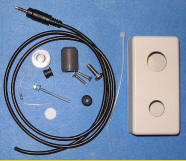 Information
on making and using pyranometers. Information
on making and using pyranometers.
Material on how to order and assemble a $20 pyranometer kit.
The References section at this link contains some in depth papers on
measuring and modeling solar radiation at the earths surface. |
My new
Thermal Imaging Camera
Some tests and impressions of my new thermal
imaging camera... |
 Thermal
imaging cameras offer an unmatched capability to view the temperatures over
a whole surface. They are a great tool for things like improving solar
collector designs. Thermal
imaging cameras offer an unmatched capability to view the temperatures over
a whole surface. They are a great tool for things like improving solar
collector designs.
They have been almost prohibitively expense, but over the last few years
have come down a lot as some entry level lines have been introduced with
lower prices that have been steadily dropping. The lowest priced ones
are now a bit over $1000 -- still a lot, but much better than $10,000.
I recently took the plunge and got a FLIR IR camera.
My impressions of the FLIR so far are
here... |
|
Heat Transfer in Solar Air Heating Collectors Made from Gutter Downspouts... |
 A
simple test to see how much heat gets transferred around to the back side of
solar air heating collectors made from gutter downspouts. A
simple test to see how much heat gets transferred around to the back side of
solar air heating collectors made from gutter downspouts.
If heat transfer to the back side of the collector is efficient, then the
effect heat transfer area from absorber to air is significantly increased,
and this should improve the efficiency of the collector. |
More PV Array Shading Tests
All the details on PV shading test... |
 These
are some simple tests to try to determine the effect of shading from nearby
power or telephone wires that cast shadows on a PV array. These
are some simple tests to try to determine the effect of shading from nearby
power or telephone wires that cast shadows on a PV array.
|
Effect of Tree Shade on Solar Collector Efficiency
AND
A Simple Way to Test All Kinds of Collector Design & Placement
VariationsAll the details on solar tree
shade test... |
 This
is a simple way to test the effect of tree shade on collector efficiency.
It uses two identical collectors each with a bottle of water inside to
collect heat. You place one collector in full sun, and the other in
the shade of the trees you are concerned about. The difference
in water temperature rise at the end of the collection period tells you how
much the shade is hurting. This
is a simple way to test the effect of tree shade on collector efficiency.
It uses two identical collectors each with a bottle of water inside to
collect heat. You place one collector in full sun, and the other in
the shade of the trees you are concerned about. The difference
in water temperature rise at the end of the collection period tells you how
much the shade is hurting.This same method could be used to compare
glazing materials, compare different collector orientations, ...
and all sorts of other variables. Its simple, practical, and accurate. |
|
Screen
Absorber Test... A Second
Set of Screen Absorber Tests...
(this one has an observation on the suitability of FG screen for absorbers) |
 This
is a simple to test to try to understand a little more about how solar
collector absorbers made from multiple layers of window
screen actually work... This
is a simple to test to try to understand a little more about how solar
collector absorbers made from multiple layers of window
screen actually work... |
|
Adventures in
Measuring Airflow for a Solar Collector... |
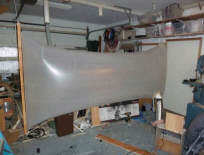 Some
notes on various ways to measure airflow for a solar collector, and how well
they work (or don't). Some
notes on various ways to measure airflow for a solar collector, and how well
they work (or don't). |
|
Effect of partial snow cover on PV panel output
Details... |
 This
little test shows the effect of having your PV panels partly covered by a
thin layer of light snow. This
little test shows the effect of having your PV panels partly covered by a
thin layer of light snow.Power output of cleared panels is compared to
the panels with some snow. |
|
Test of a Collector with Horizontal Risers
All the details...
|
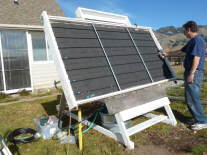 This
is a rough test of a collector in which the "risers" run horizontally
instead of vertically. This
is a rough test of a collector in which the "risers" run horizontally
instead of vertically.
It has been suggested that this arrangement might work better for the
large and wide collectors that DIYers build for space heating.
The results look encouraging to me... |
|
Best paint for solar collector absorbers
The test...
|
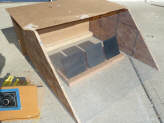 This
is a quick test to compare the temperature reached by small samples of
aluminum painted with Flat black, Gloss black, and Thermalox paint. This
is a quick test to compare the temperature reached by small samples of
aluminum painted with Flat black, Gloss black, and Thermalox paint.
Idea being that sample that reaches the highest temperature will have better
performance as a solar collector absorber finish. |
|
Variation in Riser Flow for Wide Solar Water Heating Collectors
|
 A
test of the variation in riser to riser flow rate for a wide collector with
3/4 inch top and bottom manifolds.... A
test of the variation in riser to riser flow rate for a wide collector with
3/4 inch top and bottom manifolds.... |
Using Attic Heat
Logged Attic TemperaturesDetails ...
|
 This
page goes over some potential ways of using attic heat, including preheating
water, space heating, a source for pre-heated dryer air, and pool heating. This
page goes over some potential ways of using attic heat, including preheating
water, space heating, a source for pre-heated dryer air, and pool heating.
It also provides long term plots of my attic temperature, which is probably
typical of cold many cold northern US climates. These give some feel
for the potential.
An FSEC paper on measured attic temperatures...
note the dramatic reduction in attic temps for a white roof.
|
Effect of edge gaps on the performance
of insulating shutters and shades,
William shurcliff,
Thermal Shutters and shades, 1980Details ...
(pdf) |
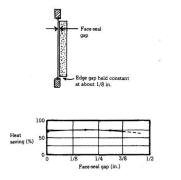 Some
simple tests that William Shurcliff did for his book Thermal Shutters and
Shades to determine how tight insulating shutters and shades need to fit in
order to not have excessive heat loss. Some
simple tests that William Shurcliff did for his book Thermal Shutters and
Shades to determine how tight insulating shutters and shades need to fit in
order to not have excessive heat loss.
Extracted from "Thermal Shutters and Shades", William Shurcliff
with permission. |
|
Effect of vent
size on thermosyphon collectors ...
Gary |
 This
is a test of the effect of changing the size of the the inlet and exit vent
for a thermosyphon collector. This
is a test of the effect of changing the size of the the inlet and exit vent
for a thermosyphon collector.
The airflow through thermosyphon collectors is driven only by the buoyancy
change of the air heated in the collector, and is sensitive to changes in
the collector flow path. |
|
Small panel tests to compare collector designs
Details...
Follow on small panel tests:
Air gap vs silicone
gap...
Conductive vs regular
silicone...
|
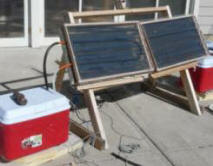 This
is a method for comparing the performance of alternative collector designs. This
is a method for comparing the performance of alternative collector designs.
It does not require much in the way of instrumentation, and it appears to
produce solid results.
Details... |
|
Large plastic pipe coil as heat exchanger
Details...
Gary |
 This
is a simple test of the thermal effectiveness of a large plastic pipe coil
used as a heat exchanger in a solar water heating system. This
is a simple test of the thermal effectiveness of a large plastic pipe coil
used as a heat exchanger in a solar water heating system.
Details... |
Serpentine Collector Drain Back Testing,
GaryDetails ...
|
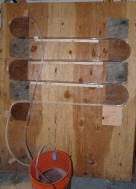 This
is a quick test to evaluate how see how well a serpentine plumbed solar
collector will drain back once the pump is stopped. This
is a quick test to evaluate how see how well a serpentine plumbed solar
collector will drain back once the pump is stopped.
Basically the tests attempt to determine if a serpentine collector can be
used in a drain back system.
Details ... |
| EPDM Collector
Test Details Here ...
Gary |
 This
is a test I did some time back in trying to see if a collector absorber
constructed from EPDM (rubber) sheet would work for my
Solar Shed
project. This
is a test I did some time back in trying to see if a collector absorber
constructed from EPDM (rubber) sheet would work for my
Solar Shed
project.
While the results were not good enough to use it on the Solar Shed, they
were not totally discouraging, and I think that the idea has some promise.
There have been successful commercial collectors made from EPDM in the past,
so there is probably some combination that works. A lower tilt
angle would also help with the water spread problem.
The appeal of an EPDM collector is that the cost could be south of $3 per
sqft -- compared to $30 per sqft for commercial collectors. |
| Transmittance of
Corrugated Glazing The Test
Gary |
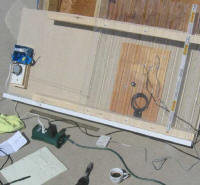 Do
the corrugations in corrugated glazing (e.g. SunTuf glazing) reduce the
solar transmittance compared to flat glazing? Do
the corrugations in corrugated glazing (e.g. SunTuf glazing) reduce the
solar transmittance compared to flat glazing?
Here is a little to test to find out. |
| Temperature
Stratification in Tall Rooms Gary |
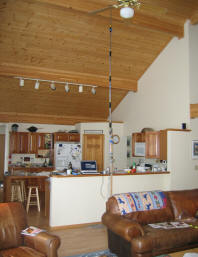 This
little test was done to settle a "discussion" about how much the hot air
tends to rise and stratify at the top of a tall room. You may be
surprised by the answer. This
little test was done to settle a "discussion" about how much the hot air
tends to rise and stratify at the top of a tall room. You may be
surprised by the answer.
More... |
|
Flow Organizer
Gary
|
 A
try at the Saunders/Delaney/Pine flow organizer. A
try at the Saunders/Delaney/Pine flow organizer. |
|
Radiant Floor Heat Spreader Plates Test
Heat Spreader Plate Test
DIY Press to make Heat Spreader Plates
Gary |
 A
little test to determine how best to install heat spreader plates for
radiant floors. A
little test to determine how best to install heat spreader plates for
radiant floors. |
|
Shower Temperature Drop Gary |
 I'm
sure you were dying to know how much the water cools from the shower head to
the shower drain -- here is the answer. I'm
sure you were dying to know how much the water cools from the shower head to
the shower drain -- here is the answer.
This drop is of interest because it is heat that cannot be recovered using a
grey water heat exchanger:
Shower Temperature Drop
A shower design that might reduce the temperature drop:
http://www.sunfrost.com/efficient_shower.html |
|
Effect of Air Filter on Thermosyphon Collector Air Flow
Details... |
 Test
measures the effect on air flow and heat output of a thermosyphon solar air
heating collector with and with out dist filters on the inlet vents. Test
measures the effect on air flow and heat output of a thermosyphon solar air
heating collector with and with out dist filters on the inlet vents.
Details... |
|
Optics Experiments On The Cheap
http://www.youtube.com/watch?v=uX9Z-nsUHiA
|
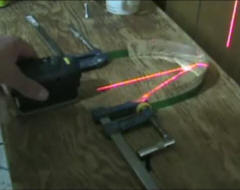 This
is a very clever and simple test setup for experimenting with curved mirror
shapes. This
is a very clever and simple test setup for experimenting with curved mirror
shapes.It allows you to quickly and easily fully visualize how a given
mirror shape will do in focusing incoming sun. It allows you to very
quickly see the effect of mirror shape changes.
While the video is aimed at refining solar cooker designs, the technique
could be used for any kind of concentrating solar application. |


 My all time favorite solar book.
Published in 1979, but still has many interesting concepts that are
well described. Out of print, but available at BookFinder, Amazon
used books, etc.
My all time favorite solar book.
Published in 1979, but still has many interesting concepts that are
well described. Out of print, but available at BookFinder, Amazon
used books, etc.
 This is David Delaney's site. He usually
has some new and interesting ideas cooking.
This is David Delaney's site. He usually
has some new and interesting ideas cooking. The latest on the
application of phase change materials for heat storage.
The latest on the
application of phase change materials for heat storage. A large
collection of experimental electric bikes and trikes. Some with
fairly detailed descriptions.
A large
collection of experimental electric bikes and trikes. Some with
fairly detailed descriptions. This is a first cut at
finding a nice looking over window solar collector design that
produces a worthwhile amount of home heating.
This is a first cut at
finding a nice looking over window solar collector design that
produces a worthwhile amount of home heating. This is an earth-sun
simulator you can build to test reflector designs or to understand
sun and shade patterns on anything you can build a model of.
This is an earth-sun
simulator you can build to test reflector designs or to understand
sun and shade patterns on anything you can build a model of. A
unique new design proposal from Nick Pine for an inexpensive solar
water heater that may be capable of very high solar fractions and
short payback.
A
unique new design proposal from Nick Pine for an inexpensive solar
water heater that may be capable of very high solar fractions and
short payback. The
goals of this system is to provide an easy to build and inexpensive
solar water heating system that uses all off the shelf components
(i.e. nothing to build yourself -- just assemble).
The
goals of this system is to provide an easy to build and inexpensive
solar water heating system that uses all off the shelf components
(i.e. nothing to build yourself -- just assemble). This is our homemade blower door that uses a furnace
blower for the fan.
This is our homemade blower door that uses a furnace
blower for the fan. and the methods
you can use to compare your house tightness to others as well as
estimate the heat loss and carbon emissions associated with
infiltration.
and the methods
you can use to compare your house tightness to others as well as
estimate the heat loss and carbon emissions associated with
infiltration. This is a set of plans
from the North Dakota State University extension for a DIY blower
door.
This is a set of plans
from the North Dakota State University extension for a DIY blower
door.
 This is a cut at a solar water heating
collector that offers a combination of high performance with a low
cost per sqft, and an easy build.
This is a cut at a solar water heating
collector that offers a combination of high performance with a low
cost per sqft, and an easy build. This is a cut at a solar
water heating collector that uses PEX tubing instead of copper to
convey the heat transfer fluid. The fins are aluminum, and a lot
of effort was put into attaining a good thermal bond between the PEX
and aluminum.
This is a cut at a solar
water heating collector that uses PEX tubing instead of copper to
convey the heat transfer fluid. The fins are aluminum, and a lot
of effort was put into attaining a good thermal bond between the PEX
and aluminum.  This is a cut at $1000, cold
climate, high performance, long life, low maintenance, and easy to
build solar water heating system.
This is a cut at $1000, cold
climate, high performance, long life, low maintenance, and easy to
build solar water heating system.
 This is a very unique
solar space heating collector. The absorber covers the entire
south wall right to the peak -- this is made possible by using an
absorber that is plumbed with tubes in a serpentine pattern rather
than they usual vertical riser pattern. The serpentine pattern
allows the absorber to be fit to the entire wall area and to
extend all the way up to the peak. The full wall glazing makes for
a very nice looking collector.
This is a very unique
solar space heating collector. The absorber covers the entire
south wall right to the peak -- this is made possible by using an
absorber that is plumbed with tubes in a serpentine pattern rather
than they usual vertical riser pattern. The serpentine pattern
allows the absorber to be fit to the entire wall area and to
extend all the way up to the peak. The full wall glazing makes for
a very nice looking collector.
 This article
covers the various ways people have worked out for making the heat
absorbing fins for collectors, fin performance, and some
construction tips.
This article
covers the various ways people have worked out for making the heat
absorbing fins for collectors, fin performance, and some
construction tips.
 This
is an innovative solar water heating system that uses unglazed
collectors with drain back for freeze protection.
This
is an innovative solar water heating system that uses unglazed
collectors with drain back for freeze protection. This is a very nice project to
incorporate a solar heating collector into a home's basic roof
structure.
This is a very nice project to
incorporate a solar heating collector into a home's basic roof
structure. e of incorporating the
collector glazing into his new roof.
e of incorporating the
collector glazing into his new roof.  Randy has worked out a way to convert a
conventional d dryer so that rather than using an internal heater to
make hot air do dry the clothes, he uses hot air produced by his
unique solar attic collector.
Randy has worked out a way to convert a
conventional d dryer so that rather than using an internal heater to
make hot air do dry the clothes, he uses hot air produced by his
unique solar attic collector. This is a very interesting project from Mik that
gives the details on building a solar cooker that stores solar
energy in a bundle
This is a very interesting project from Mik that
gives the details on building a solar cooker that stores solar
energy in a bundle of steel rods
during the daytime, and then uses the stored heat for cooking after
sunset.
of steel rods
during the daytime, and then uses the stored heat for cooking after
sunset. This is a first cut at a
livestock watering tank that is insulated and solar heated to keep
the water above freezing.
This is a first cut at a
livestock watering tank that is insulated and solar heated to keep
the water above freezing.
 This is a short description of a DIY
HRV design that was developed at the University of Saskatchewan in
the 1980.
This is a short description of a DIY
HRV design that was developed at the University of Saskatchewan in
the 1980.  Careful design
of air collector baffles and fins may allow high efficiency solar
air heating collectors that are still simple and cheap to build.
Careful design
of air collector baffles and fins may allow high efficiency solar
air heating collectors that are still simple and cheap to build.
 An experimental concept for a domestic
solar water heating that uses a pipe coil in a glazed pond to
collect energy.
An experimental concept for a domestic
solar water heating that uses a pipe coil in a glazed pond to
collect energy. This is a soon to be commercially
available, low cost, Integral Collector/Storage solar water heater.
This is a soon to be commercially
available, low cost, Integral Collector/Storage solar water heater. A new idea for solar water heating. An
antifreeze fluid is circulated through the attic ridge vent to pick
up heat from the hot air exiting the ridge vent. The fluid is
A new idea for solar water heating. An
antifreeze fluid is circulated through the attic ridge vent to pick
up heat from the hot air exiting the ridge vent. The fluid is routed
through a heat exchanger that is embedded in a solar preheat water
tank -- this preheats the water before it gets to the regular hot
water tank.
routed
through a heat exchanger that is embedded in a solar preheat water
tank -- this preheats the water before it gets to the regular hot
water tank.


 tegrated with
the roof structure and a unique thermal storage system to provide
solar thermal heating in the winter and radiation cooling in the
summer. Amazing!
tegrated with
the roof structure and a unique thermal storage system to provide
solar thermal heating in the winter and radiation cooling in the
summer. Amazing! This is a
simple, building integrated, cooling scheme that uses nighttime
radiation cooling from a metal roof to cool air in the attic space.
Attic air is then circulated into the living area to provide
cooling.
This is a
simple, building integrated, cooling scheme that uses nighttime
radiation cooling from a metal roof to cool air in the attic space.
Attic air is then circulated into the living area to provide
cooling. A new idea for low cost, high temperature solar
collectors.
A new idea for low cost, high temperature solar
collectors. This is an idea
for a simple, cheap and efficient homemade pool heating collector.
This is an idea
for a simple, cheap and efficient homemade pool heating collector.
 This idea uses
solar collectors and heat storage tank installed in a multi-purpose
outbuilding to provide space heating for the nearby house.
This idea uses
solar collectors and heat storage tank installed in a multi-purpose
outbuilding to provide space heating for the nearby house.
 This is exactly
the same collector listed just above, but used for cooling instead
of heating. The idea is that at night water from a storage tank is
pumped over the collector surface to cool. The water cools by
radiation to the night sky and evaporation. The chilled water in
the storage tank would be used for space cooling the next day.
This is exactly
the same collector listed just above, but used for cooling instead
of heating. The idea is that at night water from a storage tank is
pumped over the collector surface to cool. The water cools by
radiation to the night sky and evaporation. The chilled water in
the storage tank would be used for space cooling the next day. This is a first cut at a full scale
implementation of the evapro/radiative cooling system described just
above.
This is a first cut at a full scale
implementation of the evapro/radiative cooling system described just
above.

 Nathan's low tech AC uses a tank with
cool water coupled to an air to an efficient air to water heat
exchanger (car radiator).
Nathan's low tech AC uses a tank with
cool water coupled to an air to an efficient air to water heat
exchanger (car radiator).
 This is an interesting idea for a
collector. It uses the channels in a Twinwall glazing sheet as flow
passages for water. Slotted pipes fit over the ends of the twinwall
sheet to act as manifolds.
This is an interesting idea for a
collector. It uses the channels in a Twinwall glazing sheet as flow
passages for water. Slotted pipes fit over the ends of the twinwall
sheet to act as manifolds. Some thoughts on developing
high R value thermal window shades.
Some thoughts on developing
high R value thermal window shades.
 A first prototype of a solar air heating
collector that fits over an existing window, and uses the window to
get air into and out of the collector.
A first prototype of a solar air heating
collector that fits over an existing window, and uses the window to
get air into and out of the collector.
 An insulating window shade
that also acts as a solar collector, and that automatically
transitions from one to the other depending on conditions.
An insulating window shade
that also acts as a solar collector, and that automatically
transitions from one to the other depending on conditions. This is a
really fine book on all aspects of designing and building a wide
variety of solar batch water heaters.
This is a
really fine book on all aspects of designing and building a wide
variety of solar batch water heaters. This is a try at a very easy
to build and cheap solar flat plate collector that uses CPVC pipe,
and extruded alum radiant floor heat spreaders.
This is a try at a very easy
to build and cheap solar flat plate collector that uses CPVC pipe,
and extruded alum radiant floor heat spreaders.
 The solar collector shown here was developed in the
70's as a very inexpensive greenhouse heater. It works well for
situations in which only low temperatures are required (like
greenhouses and pools).
The solar collector shown here was developed in the
70's as a very inexpensive greenhouse heater. It works well for
situations in which only low temperatures are required (like
greenhouses and pools).
 An interesting
idea for coupling a low thermal mass solar collection area with a
well insulated, high temperature heat storage area that is used as
a "solar battery" to heat the attached house during cloudy periods.
An interesting
idea for coupling a low thermal mass solar collection area with a
well insulated, high temperature heat storage area that is used as
a "solar battery" to heat the attached house during cloudy periods. This is a simple and
effective grey water heat exchanger from Tyler that captures some
of the heat from your shower drain water in order to preheat water
on its way to the shower.
This is a simple and
effective grey water heat exchanger from Tyler that captures some
of the heat from your shower drain water in order to preheat water
on its way to the shower. An innovative
version of a grey water heat exchanger that may be able to recover a
large fraction of the heat that normally goes down the drain. It is
inexpensive and is constructed inside a standard steel barrel.
An innovative
version of a grey water heat exchanger that may be able to recover a
large fraction of the heat that normally goes down the drain. It is
inexpensive and is constructed inside a standard steel barrel. An interesting and simple
experimental setup to show the potential (and some of the problems)
of capturing heat from grey water from the shower.
An interesting and simple
experimental setup to show the potential (and some of the problems)
of capturing heat from grey water from the shower. A potential simple scheme for recovering
heat in shower water for use in space heating is described.
A potential simple scheme for recovering
heat in shower water for use in space heating is described.
 An approach that
was looked into for implementing showers onboard commercial
airplanes is discussed as a potential very low energy approach for
home showers.
An approach that
was looked into for implementing showers onboard commercial
airplanes is discussed as a potential very low energy approach for
home showers. Thoughts and schemes to allow endless hot
water showers at high flow rates with very little energy use.
Thoughts and schemes to allow endless hot
water showers at high flow rates with very little energy use.

 A scheme to use soap bubbles as
insulation on greenhouses (or other structures) to prevent night
heat loss.
A scheme to use soap bubbles as
insulation on greenhouses (or other structures) to prevent night
heat loss. Pretty detailed description
of a building using the soap bubble insulation scheme. An
interesting site -- with some new ideas.
Pretty detailed description
of a building using the soap bubble insulation scheme. An
interesting site -- with some new ideas.



 An
experimental, low-cost heliostat design that uses air pressure to
focus and support the mirror.
An
experimental, low-cost heliostat design that uses air pressure to
focus and support the mirror. 
 This is the site of my friend, co-worker,
and very creative inventor -- Mithra. We have worked together on
several projects, including the inflatable heliostat just above.
This is the site of my friend, co-worker,
and very creative inventor -- Mithra. We have worked together on
several projects, including the inflatable heliostat just above. This paper on a PV powered irrigation pumping
includes an interesting scheme to increase PV output. It has fixed
reflectors on each side of the PV panels, and a single axis tracking
system to point the entire rig toward the sun. The reflectors are
said to increase panel output by 33% (not counting the tracking
benefit).
This paper on a PV powered irrigation pumping
includes an interesting scheme to increase PV output. It has fixed
reflectors on each side of the PV panels, and a single axis tracking
system to point the entire rig toward the sun. The reflectors are
said to increase panel output by 33% (not counting the tracking
benefit).
 This 1981 paper with a 2004 update describes a solar
heated house with a "flooded subfloor" thermal storage area.
This 1981 paper with a 2004 update describes a solar
heated house with a "flooded subfloor" thermal storage area.


 While
PaperCrete has been around quite a while, it has just started to be
used for home construction, so this is for adventurous
experimenters.
While
PaperCrete has been around quite a while, it has just started to be
used for home construction, so this is for adventurous
experimenters.
 Roof sprinkler system lowers
roof temperature and cooling bills by keeping the roof cooler
through water evaporation.
Roof sprinkler system lowers
roof temperature and cooling bills by keeping the roof cooler
through water evaporation. This is an interesting set of concepts
that use the heat generated through the decomposition of organic
mater for space and water heating.
This is an interesting set of concepts
that use the heat generated through the decomposition of organic
mater for space and water heating.
 New Alberta
community uses 2300 sq meters of solar thermal collectors to collect
heat in the summer for use in the winter. Heat is stored in a field
of 144 boreholes, and distributed by a common heating loop serving
the 52 houses.
New Alberta
community uses 2300 sq meters of solar thermal collectors to collect
heat in the summer for use in the winter. Heat is stored in a field
of 144 boreholes, and distributed by a common heating loop serving
the 52 houses. This looks like a pretty simple way to
get sustain high growth rates and oil production from algae?
This looks like a pretty simple way to
get sustain high growth rates and oil production from algae?
 An interesting
solar wall/window construction that was used on the MIT Solar
Decathlon entry.
An interesting
solar wall/window construction that was used on the MIT Solar
Decathlon entry. A system from
Invisible Heating Systems Ltd that embeds plastic pipe in asphalt
pavement to recover heat.
A system from
Invisible Heating Systems Ltd that embeds plastic pipe in asphalt
pavement to recover heat. Eliosolar makes a line of
architectural shading structures that double as solar water
heaters. So, potentially you get the double benefit of reducing the
building AC bills and also making free hot water. They are in the
process or getting SRCC approval, and it will be interesting to see
what the efficiency as solar water heaters comes out to, but even if
its quite low (as one would expect from the unglazed design), maybe
the double benefit makes it worthwhile.
Eliosolar makes a line of
architectural shading structures that double as solar water
heaters. So, potentially you get the double benefit of reducing the
building AC bills and also making free hot water. They are in the
process or getting SRCC approval, and it will be interesting to see
what the efficiency as solar water heaters comes out to, but even if
its quite low (as one would expect from the unglazed design), maybe
the double benefit makes it worthwhile. Eco Wave Power is
developing a couple types of simple wave powered electric
generators.
Eco Wave Power is
developing a couple types of simple wave powered electric
generators. For power
generation stations that use a central tower to collect sunlight
reflected from a field of heliotstat, the heliostats are the major
cost element, so simpler and cheaper heliostat designs have a big
payoff.
For power
generation stations that use a central tower to collect sunlight
reflected from a field of heliotstat, the heliostats are the major
cost element, so simpler and cheaper heliostat designs have a big
payoff. An
interesting idea for a helium inflated wind generator.
An
interesting idea for a helium inflated wind generator. "This
innovation spray-cools water on the roof at night and applies the cooled
water to reduce subsequent cooling loads. On clear nights, the sky is much
colder than outdoor air, contributing to high water cooling rates through a
combination of evaporation and sky radiation. Overnight, NightSky systems
can typically cool a large storage volume (preferably two gallons per square
"This
innovation spray-cools water on the roof at night and applies the cooled
water to reduce subsequent cooling loads. On clear nights, the sky is much
colder than outdoor air, contributing to high water cooling rates through a
combination of evaporation and sky radiation. Overnight, NightSky systems
can typically cool a large storage volume (preferably two gallons per square A
new solar thermal electric power generation installation in Nevada with some
improvements.
A
new solar thermal electric power generation installation in Nevada with some
improvements. Michael
has shows some interesting concepts in home/building design. Some of
these have the potential for good energy efficiency -- as in the Home-Scape
pictured here.
Michael
has shows some interesting concepts in home/building design. Some of
these have the potential for good energy efficiency -- as in the Home-Scape
pictured here.  An
interesting test rig to measure the side by side performance of two test
windows under actual field conditions.
An
interesting test rig to measure the side by side performance of two test
windows under actual field conditions. An
interesting new UK product. These are standard roof tiles that are
solar collectors. There is a solar thermal version that heats water,
and a solar
An
interesting new UK product. These are standard roof tiles that are
solar collectors. There is a solar thermal version that heats water,
and a solar PV version that generates electricity.
PV version that generates electricity.  An
interesting concept for a solar wall heater. The absorber has
integrated heat storage in the form of Phase Change Material. The
objective is to store heat during the day in the PCM, and let the PCM warm
the wall that the collector is mounted on at night -- this reduces heat loss
through the wall.
An
interesting concept for a solar wall heater. The absorber has
integrated heat storage in the form of Phase Change Material. The
objective is to store heat during the day in the PCM, and let the PCM warm
the wall that the collector is mounted on at night -- this reduces heat loss
through the wall.  These
panels have R values that are about 10 times greater per inch that
conventional insulating materials.
These
panels have R values that are about 10 times greater per inch that
conventional insulating materials. This
Australian design has some features in common with the Horizontal Pond
scheme just above, and some new features. The case is rotationally
molded PE, it incorporates two layers of glazing with a transparent
honeycomb material between them for insulation. The sun heats the
bath, and transfers heat to an immersed coil of copper pipe. The
prices seem on the high side given what looks like a cheap manufacturing
process?
This
Australian design has some features in common with the Horizontal Pond
scheme just above, and some new features. The case is rotationally
molded PE, it incorporates two layers of glazing with a transparent
honeycomb material between them for insulation. The sun heats the
bath, and transfers heat to an immersed coil of copper pipe. The
prices seem on the high side given what looks like a cheap manufacturing
process? An interesting idea to use the normally wasted heat from PV panels for
thermal heating. Should about triple the useful energy output
from the PV panel.
An interesting idea to use the normally wasted heat from PV panels for
thermal heating. Should about triple the useful energy output
from the PV panel. This
system is a combined PV and solar thermal system. Conventional PV
panels are mounted above the roof plane leaving a space between the roof and
the bottom of the PV panels. The top and sides of the PV array are
sealed to the roof. Fresh air is drawn in under the PV panels along
the open bottom edge, and is heated as it progresses up between the hot PV
panels and the roof. Vents at the top of the array take the heated air
into the house and use the heated air to heat domestic water and/or for
space heating.
This
system is a combined PV and solar thermal system. Conventional PV
panels are mounted above the roof plane leaving a space between the roof and
the bottom of the PV panels. The top and sides of the PV array are
sealed to the roof. Fresh air is drawn in under the PV panels along
the open bottom edge, and is heated as it progresses up between the hot PV
panels and the roof. Vents at the top of the array take the heated air
into the house and use the heated air to heat domestic water and/or for
space heating.


 Greenway is developing a PV
module with an integrated inverter. Detail is a bit sketchy, but it
appears that the intent is that these modules can be strung together, and
then plugged into an outlet. They are specifically designed for easy
DIY installation.
Greenway is developing a PV
module with an integrated inverter. Detail is a bit sketchy, but it
appears that the intent is that these modules can be strung together, and
then plugged into an outlet. They are specifically designed for easy
DIY installation. Home
cogeneration systems offer the possibility of putting the waste heat
produced when generating electricity to a useful purpose (heating your
home). The end result could be some cost saving, and an about 30%
reduction in green house gas production.
Home
cogeneration systems offer the possibility of putting the waste heat
produced when generating electricity to a useful purpose (heating your
home). The end result could be some cost saving, and an about 30%
reduction in green house gas production. Another
residential cogeneration system that comes in either an on-grid AC version
or and off-grid DC version.
Another
residential cogeneration system that comes in either an on-grid AC version
or and off-grid DC version. A side by side test of two of the most popular solar air heating collector designs: the pop can absorber and screen absorber.
A side by side test of two of the most popular solar air heating collector designs: the pop can absorber and screen absorber. This
is a stagnaton test on our $2K vertical double glazed collector.
This
is a stagnaton test on our $2K vertical double glazed collector. I
did a side by side test of Scott's new design
I
did a side by side test of Scott's new design
 of
the CPVC/aluminum collector comparing it to the copper/aluminum
collector.
of
the CPVC/aluminum collector comparing it to the copper/aluminum
collector.  This
was a quick test to see how CPVC and PEX faired in elevated temperatures up
to about 260F.
This
was a quick test to see how CPVC and PEX faired in elevated temperatures up
to about 260F. This
is a project to do a sun simulator that will allow indoor testing of
collectors up to 2 by 4 ft.
This
is a project to do a sun simulator that will allow indoor testing of
collectors up to 2 by 4 ft. This
is a first test of a collector design that Nick Pine has proposed that
promises to provide higher collector output temperatures without as much
degradation in efficiency as usually occurs.
This
is a first test of a collector design that Nick Pine has proposed that
promises to provide higher collector output temperatures without as much
degradation in efficiency as usually occurs. Some
new testing on our nearly 10 year old thermosyphon solar shop heating
collector.
Some
new testing on our nearly 10 year old thermosyphon solar shop heating
collector. An
attempt to get an idea whether the flow distribution in horizontal
collectors with horizontal airflow tends to be distorted by the buoyancy
forces on the heated air.
An
attempt to get an idea whether the flow distribution in horizontal
collectors with horizontal airflow tends to be distorted by the buoyancy
forces on the heated air. This
is a test to compare the performance of twinwall polycarbonate glazing to
single wall clear Acrylic glazing for solar collectors under cold weather
conditions.
This
is a test to compare the performance of twinwall polycarbonate glazing to
single wall clear Acrylic glazing for solar collectors under cold weather
conditions. This
is a full winters worth of side by side testing of several DIY solar air
heating collector tests.
This
is a full winters worth of side by side testing of several DIY solar air
heating collector tests.
 Information
on making and using pyranometers.
Information
on making and using pyranometers.
 Thermal
imaging cameras offer an unmatched capability to view the temperatures over
a whole surface. They are a great tool for things like improving solar
collector designs.
Thermal
imaging cameras offer an unmatched capability to view the temperatures over
a whole surface. They are a great tool for things like improving solar
collector designs. A
simple test to see how much heat gets transferred around to the back side of
solar air heating collectors made from gutter downspouts.
A
simple test to see how much heat gets transferred around to the back side of
solar air heating collectors made from gutter downspouts. These
are some simple tests to try to determine the effect of shading from nearby
power or telephone wires that cast shadows on a PV array.
These
are some simple tests to try to determine the effect of shading from nearby
power or telephone wires that cast shadows on a PV array. This
is a simple way to test the effect of tree shade on collector efficiency.
It uses two identical collectors each with a bottle of water inside to
collect heat. You place one collector in full sun, and the other in
the shade of the trees you are concerned about. The difference
in water temperature rise at the end of the collection period tells you how
much the shade is hurting.
This
is a simple way to test the effect of tree shade on collector efficiency.
It uses two identical collectors each with a bottle of water inside to
collect heat. You place one collector in full sun, and the other in
the shade of the trees you are concerned about. The difference
in water temperature rise at the end of the collection period tells you how
much the shade is hurting. Some
notes on various ways to measure airflow for a solar collector, and how well
they work (or don't).
Some
notes on various ways to measure airflow for a solar collector, and how well
they work (or don't). This
little test shows the effect of having your PV panels partly covered by a
thin layer of light snow.
This
little test shows the effect of having your PV panels partly covered by a
thin layer of light snow. This
is a quick test to compare the temperature reached by small samples of
aluminum painted with Flat black, Gloss black, and Thermalox paint.
This
is a quick test to compare the temperature reached by small samples of
aluminum painted with Flat black, Gloss black, and Thermalox paint.
 This
page goes over some potential ways of using attic heat, including preheating
water, space heating, a source for pre-heated dryer air, and pool heating.
This
page goes over some potential ways of using attic heat, including preheating
water, space heating, a source for pre-heated dryer air, and pool heating. Some
simple tests that William Shurcliff did for his book Thermal Shutters and
Shades to determine how tight insulating shutters and shades need to fit in
order to not have excessive heat loss.
Some
simple tests that William Shurcliff did for his book Thermal Shutters and
Shades to determine how tight insulating shutters and shades need to fit in
order to not have excessive heat loss.  This
is a test of the effect of changing the size of the the inlet and exit vent
for a thermosyphon collector.
This
is a test of the effect of changing the size of the the inlet and exit vent
for a thermosyphon collector. This
is a method for comparing the performance of alternative collector designs.
This
is a method for comparing the performance of alternative collector designs.
 This
is a simple test of the thermal effectiveness of a large plastic pipe coil
used as a heat exchanger in a solar water heating system.
This
is a simple test of the thermal effectiveness of a large plastic pipe coil
used as a heat exchanger in a solar water heating system. This
is a quick test to evaluate how see how well a serpentine plumbed solar
collector will drain back once the pump is stopped.
This
is a quick test to evaluate how see how well a serpentine plumbed solar
collector will drain back once the pump is stopped. This
is a test I did some time back in trying to see if a collector absorber
constructed from EPDM (rubber) sheet would work for my
This
is a test I did some time back in trying to see if a collector absorber
constructed from EPDM (rubber) sheet would work for my
 Do
the corrugations in corrugated glazing (e.g. SunTuf glazing) reduce the
solar transmittance compared to flat glazing?
Do
the corrugations in corrugated glazing (e.g. SunTuf glazing) reduce the
solar transmittance compared to flat glazing? This
little test was done to settle a "discussion" about how much the hot air
tends to rise and stratify at the top of a tall room. You may be
surprised by the answer.
This
little test was done to settle a "discussion" about how much the hot air
tends to rise and stratify at the top of a tall room. You may be
surprised by the answer. A
little test to determine how best to install heat spreader plates for
radiant floors.
A
little test to determine how best to install heat spreader plates for
radiant floors. I'm
sure you were dying to know how much the water cools from the shower head to
the shower drain -- here is the answer.
I'm
sure you were dying to know how much the water cools from the shower head to
the shower drain -- here is the answer. Test
measures the effect on air flow and heat output of a thermosyphon solar air
heating collector with and with out dist filters on the inlet vents.
Test
measures the effect on air flow and heat output of a thermosyphon solar air
heating collector with and with out dist filters on the inlet vents. This
is a very clever and simple test setup for experimenting with curved mirror
shapes.
This
is a very clever and simple test setup for experimenting with curved mirror
shapes.